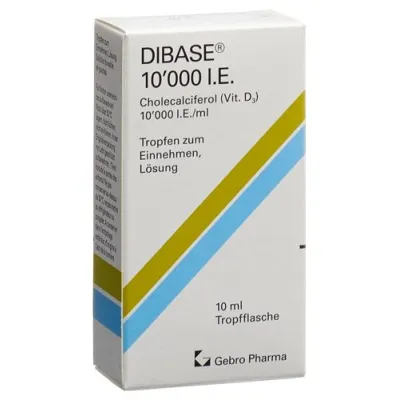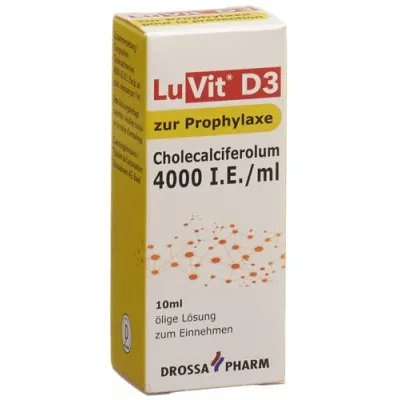rickets prevention
(1 Pages)
Dibase drops 10000 iu/ml bottle 10 ml
What is DIBASE 10'000 and when is it used? DIBASE 10'000 oral drops contain cholecalciferol (vitamin D3). Vitamin D3 is found in some foods and is also made by the body when the skin is exposed to sunlight. Vitamin D3 helps the kidneys and intestines to absorb calcium and is needed for building bones.DIBASE 10,000 drops for oral use are used:To prevent bone softening in children (rickets)To prevent bone softening in adults (osteomalacia)to prevent a recognizable risk of vitamin D deficiency disease otherwise healthy people without disturbances in food intake (absorption disturbances)to prevent a recognizable risk of vitamin D deficiency disease with reduced intake from food (malabsorption)On prescription from DIBASE 10'000 drops for oral use are used:to prevent possible bone softening in premature babies, infants and small children (rickets)for treatment of bone softening (osteomalacia) in adults.for the treatment of all forms and stages of ricketsWhen should DIBASE 10'000 not be taken?if you are allergic to vitamin D3 or any of the other ingredients of this medicine;if you have high levels of calcium in your blood, kidney problems and any disease with already existing increase in calcium levels in the blood or urine (hypercalcaemia and/or hypercalciuria)if you tend to form calcium-containing kidney stones;if you have a high concentration of vitamin D in your have blood (hypervitaminosis D).if you are acutely suffering from pulmonary tuberculosisif you are bedridden for a long time (e.g. after surgery)In infants and toddlers if present hypothyroidismIf you are taking other vitamin D preparations at the same time or if you are taking certain diuretic drugs (e.g. thiazides for high blood pressure)When should DIBASE 10' be taken? 000 Caution required?Using DIBASE 10'000 together with other medicinesTell your doctor or pharmacist if you are using other medicines, have recently used other medicines or maybe other medicines will apply. This is especially important if you are taking the following medicines:Medicines that affect the heart or kidneys, such as cardiac glycosides (e.g. digoxin) or diuretics (e.g. bendroflumethazide ). When used at the same time as vitamin D3, these medicines can lead to a significant increase in the concentration of calcium in the blood and urine;Medicines containing vitamin D3 or if you eat foods rich in vitamin D, such as certain Consume types of milk fortified with vitamin D3;actinomycin (a medicine used to treat certain forms of ) and imidazole antifungals (e.g. clotrimazole and ketoconazole, medicines used to treat fungal infections). These medicines can affect how the body uses vitamin D3;the following medicines, as they may affect how vitamin D3 works or how well it is absorbed;Medicines for epilepsy (anticonvulsants), barbituratesGlucocorticoids (steroid s such as hydrocortisone or prednisolone). These can reduce the effect of vitamin D3;medicines to lower the cholesterol level in the blood (e.g. cholestyramine or colestipol);certain medicines for weight controleducators that reduce the absorption of fat in the body (e.g. orlistat);certain laxatives (e.g. liquid paraffin).All D-vitamins are harmful in high doses. Uncontrolled intake (without a doctor's prescription) of high doses over a longer period of time should be avoided.Please talk to your doctor, pharmacist or nurse before using DIBASE 10'000 if you:are currently taking certain medications for heart diseases (e.g. with cardiac glycosides such as digoxin), medications for high blood pressure (diuretics such as thiazides), medications for epilepsy ( e.g. phenytoin, barbiturates), cholesterol-lowering drugs (colestyramine, colestipol), certain laxatives (paraffin oil), weight-loss drugs (orlistat), anti-fungal drugs (imidazole preparations) or cortisone preparationshave sarcoidosis (an immune system disorder in which the levels of vitamin D in the body may be increased);are taking medicines that contain vitamin D3 , or are consuming foods or milk fortified with vitamin D3;are likely to spend a lot of time in the sun while using DIBASE 10'000;take other calcium supplements. Your doctor will check the calcium concentration in your blood while you are using DIBASE 10'000 to make sure it is not too high.have kidney damage or kidney disease. Your doctor may measure the calcium concentration in your blood or urine.Have calcium metabolism disorders, kidney stones or heart diseaseInform your doctor, pharmacist or druggist if yousuffer from other diseasesHave allergies orOther medicines (including those you bought yourself!) Can DIBASE 10'000 be taken while pregnant or breastfeeding?If you are pregnant or breastfeeding, think you may be pregnant or are planning to have a baby, ask your doctor or pharmacist for advice before taking this medicine. DIBASE 10'000 should only be used during pregnancy and breastfeeding if recommended by a doctor.How do you use DIBASE 10'000?Observe the dosage given in the package insert or prescribed by the doctor. If you think the medicine is too weak or too strong, talk to your doctor, pharmacist or druggist.1 drop contains 200 IU of vitamin D3.Shake before use.You should preferably take this medicine with a main meal so that your body can absorb the vitamin D3 more easily. To make it easier to take, you can also mix the drops with cold or lukewarm food.This medicine tastes slightly like olive oil. It can be taken straight from the bottle. Alternatively, the prescribed number of drops can be mixed into a spoon with or a small amount of cold or lukewarm food immediately before taking it. Make sure you take the whole dose. For children, DIBASE 10'000 can be mixed with a small amount of baby food, yoghurt, milk, cheese or other milk products. Do not mix DIBASE 10'000 with the contents of a milk bottle or put it in a container with soft food, as your child may not eat the whole portion and then not get the full dose. You should make sure that the whole dose is taken. Children who are no longer breastfed should be given the prescribed dose mit be administered after a larger meal. Do not keep products or food to which DIBASE 10'000 has been added for later use or to take with the next meal. Use in children and adolescents The recommended dose is: According to medical prescription to prevent deficiency states in 0 to 1 year olds: 400 IU/day ( 2 drops), in premature babies 400-800 IU/day (2-4 drops)To prevent deficiencies in 1 to 18 year olds: 600 IU/day (3 drops)Depending on your doctor's instructions, higher doses may be required.As prescribed by a doctor to treat deficiencies in 0 to 1 year olds: 400-1'000 IU/day (2 -5 drops)According to medical prescription for the treatment of deficiencies in 1 to 18 year olds: 5 - 25 drops (corresponding to 1'000 - 5'000 IU) per day during the first 6 weeks, followed by 3 - 5 drops (corresponding to 600 - 1'000 IU) per day.Application during pregnancy and lactation The recommended dose is :To prevent deficiencies: 400 IU/day (2 drops)Depending on your doctor's advice, higher doses may be necessary.As prescribed by your doctor to treat deficiencies: 1'400 – 2'000 IU/day (7-10 drops)Use in adultsThe recommended dose is:For the prevention of vitamin D deficiency in adults 19 to 59 years: 600 IU/day (3-4 drops).For the prevention of vitamin D deficiency in adults ≥60 years: 800 IU/day (4 drops).For the prevention of vitamin D deficiency in adults with malabsorption: 3'000 - 4'0 00 IU/day (15-20 drops).Higher doses may be required as directed by your doctor.As prescribed by a doctor to treat deficiencies in adults with an identified risk of vitamin D deficiency: 1'400 - 2'000 IU/day (7-10 drops)As prescribed by a doctor to treat deficiencies in adults with osteomalacia: 1'000 - 4'000 IU/day (5-20 drops)Instructions for useThe pack contains 1 bottle and a cap with a dropper. The bottle is sealed with a child-resistant plastic cap. The dropper is protected by a plastic cylinder. Shake the bottle before use and follow the instructions below:To open the bottle, press down and twist the cap at the same time (see figure 1).Before using the cap with dropper, the plastic cylinder must be unscrewed from the cap with dropper (see figure 2).Insert the cap with dropper into the bottle to absorb the contents. Put the prescribed number of drops on a spoon.Close the bottle with the lid (see figure 3). Put the dropper back in the plastic cylinder and screw it on.Put the medicine bottle and the dropper back in the original packaging.Figure 1Figure 2 Figure 3 If you take more DIBASE 10'000 than you shouldIf you or your child take more of the medicine than you should, do not take any more of the medicineusing and contact your doctor. If a doctor is unavailable, go to the nearest hospital casualty department and take the medicine container with you. The most common symptoms of overdose are: tiredness, drowsiness, weakness, loss of appetite, nausea, vomiting, dizziness, movement disorders, headache, muscle and joint pain, muscle weakness, severe thirst, production of high levels of urine for 24 hours, rashes, constipation, diarrhea and dehydration, and high levels of calcium in the blood (hypercalcaemia and hypercalciuria) when measured by laboratory tests.If you forget to take DIBASE 10'000If you forget to take a dose of DIBASE 10'000, take the missed dose as soon as possible. Then take the next dose at the scheduled time. However, when taking the next dose is imminent, let the forgotten dose omit and only take the next dose as usual. do not take a double dose to compensate for a forgotten dose. If you have any further questions about the application of this drug, contact your doctor or pharmacist. Like all medicines, this medicine can have side effects, but this does not have to occur with everyone. The following possible side effects have been described when using DIBASE 10'000:Uncommon (affects less than 1 in 100 people)Too much calcium in the blood (hypercalcaemia)Too much calcium in the urine (hypercalciuria)Rare (affects less than 1 in 1,000 people)Skin rashItchingHivesIf you notice any side effects that are not described here, you should tell your doctor, pharmacist or pharmacist.What else needs to be considered?Keep this medicine out of the reach and sight of children EXP. Do not store above 30°C. Keep the bottle in the outer carton in order to protect from light. Do not freeze or refrigerate. Shelf life 6 months after first opening. Do not take this medicine if the solution is cloudy. Do not throw away any medicines via wastewater or household waste. Ask your pharmacist how to dispose of medicines you no longer use. What does DIBASE 10,000 contain? The active substance is cholecalciferol (vitamin D3). 1 ml oral solution (50 drops) contains 10,000 IU cholecalciferol (vitamin D3), equivalent to 0.25 mg. 1 drop contains 200 IU cholecalciferol (vitamin D3).Excipients: refined olive oil.Approval number65856 (Swissmedic).Where can you get DIBASE 10,000? Which packs are available? DIBASE 10'000 drops for oral use: 1 pack of 10 ml with dropper insert. DIBASE 10'000 is available in pharmacies and drugstores without a doctor's prescription. Authorization holder >Gebro Pharma AG, Liestal. This leaflet was last published in August 2015 by the medicinal products authority (Swissmedic)...
27.39 USD
Luvit d3 cholecalciferolum oily solution 4000 iu/ml for prophylaxis
AMZV What is LuVit D3 and when is it used? LuVit D3 is an oily solution with cholecalciferol (vitamin D3). Vitamin D3 can normally be produced in the skin under the influence of sunlight. Vitamin D3 is necessary and indispensable for calcium absorption from food for normal bone formation.If there is insufficient exposure to the sun, insufficient intake of vitamin D3-enriched foods and if there is an increased need for vitamin D3 during growth, pregnancy and lactation, the body must also be offered this vitamin.LuVit D3 is used for the following diseases:-prevention of softening of the bones in the child (rickets);-prevention of osteoporosis deviation in adults (osteomalacia);-Preventive doses: strong growth phases, pregnancy and lactation.When should LuVit D3 not be used?-Only take the dose prescribed by your doctor for the specified period of time.-Avoid taking excessive vitamin D doses for months or years, especially if you are taking calcium and/or vitaminized nutrients at the same time average (e.g. bottle preparations).-Vitamin D preparations must not be used in conditions with an increased calcium content in the blood or urine or in excretion disorders of the kidneys.When is caution required when taking LuVit D3?All D-vitamins are harmful if they are taken in excessive doses (more than 1000-3000 lU per kg body weight).In the event of calcium disorders change, kidney disease and heart disease require special care. In these cases, you should consult your doctor.Inform your doctor, pharmacist or druggist if you suffer from other illnesses, have allergies or are taking other medicines (even those you bought yourself!) or use them externally!Can LuVit D3 be taken during pregnancy or while breastfeeding?Based on previous experience, with more than as intended Application no known risk for the child. However, systematic scientific investigations have never been carried out. As a precaution, you should avoid taking medicines during pregnancy and breastfeeding, or ask your doctor, pharmacist or druggist for advice.How do you use LuVit D3?To prevent ricketsYour doctor usually prescribes 0.1 ml (=400 IU) per day, in premature babies 0.1 - 0.2 ml (=400 - 800 IU) daily until the end of the first year of life.Possibly in the second year of life during the months with little sun 0.1 ml (=400 IU) should also be administered.PregnancyDaily 0.1 ml (= 400 IU) from the 6th to the 9th Month of pregnancy.Breast feedingDaily 0.1 ml (= 400 IU).Application of the solutionLu Vit D3 is taken undiluted.The solution is administered with a spoon.It is important to ensure that the pipette does not come into contact with the mouth, saliva or food.If daily administration of the oral solution is not feasible, the doctor must be consulted.Follow the instructions given in the package insert or by the doctor or the dosage prescribed by the doctor. If you think the medicine is too weak or too strong, talk to your doctor, pharmacist or druggist.What side effects can LuVit D3 have?With the prescribed dosage, no side effects are to be expected.If you notice any side effects that are not described hereshould inform your doctor or pharmacist.What else needs to be considered?The medicinal product may only be used up to the date marked «EXP» on the container.Store in the original packaging at room temperature (15-25 °C) and protected from light.Keep out of the reach of children.Shelf life 3 months after opening.Cloudy Do not use the solution.Your doctor, pharmacist or druggist can provide you with further information. These people have the detailed information for professionals.What does LuVit D3 contain?1 ml contains:Active ingredient: cholecalciferol 4000 international units (IU) and excipients.Authorization number66124 (Swissmedic)Where can you get LuVit D3? What packs are available? In pharmacies and drugstores, without a doctor's prescription. Packs of 10 ml with a dosing pipette, graduated in 0.05/0.1 ml.Packs of 20 ml with a dosing pipette, graduated in 0.10/0.15/0.20 mlAuthorization holder Drossapharm AG, 4002 Basel.This leaflet was last checked by the drug authority (Swissmedic) in September 2013...
12.38 USD
Vitamin d3 streuli 4000 iu/ml prophylaxis oral solution 10
AMZVWhat is Vitamin D3 Streuli and when is it used? Vitamin D3 Streuli is an oily solution with cholecalciferol (vitamin D3). Humans can normally produce vitamin D3 themselves under the influence of sunlight in the skin.Vitamin D3 is necessary for the absorption of calcium from food and is essential for normal bone formation.In the case of insufficient exposure to the sun, insufficient intake of vitamin D3-enriched foods and an increased need for vitamin D3 during growth, pregnancy and lactation, the body must also be offered this vitamin.Vitamin D3 Streuli is used for the following diseases:Prevention of softening of bones in children (rickets);Prevention of softening of bones in adults (osteomalacia);Preventive doses: strong growth phases, pregnancy and breastfeeding.When may vitamin D3 Streuli are not used?Only take the dose prescribed by your doctor for the specified period of time.Avoid taking excessive vitamin D doses for months or years, especially if you are also taking calcium and/or vitamin-enriched nutrients (e.g. bottle preparations).Vitamin D preparations must not be used in conditions with an increased calcium content in the blood or urine or in excretion disorders of the kidneys.When should caution be taken when taking vitamin D3 Streuli?All D vitamins are harmful if they are taken in excessive doses (more than 1000-3000 lU per kg body weight).Particular caution is required in the case of disorders of the calcium metabolism, kidney diseases and heart diseases. In these cases, you should consult your doctor.Inform your doctor, pharmacist or druggist if you suffer from other illnesses, have allergies or are taking other medicines (including those you bought yourself!) or use them externally!Can vitamin D3 Streuli be taken during pregnancy or while breastfeeding? Based on previous experience, there is no known risk for the child when used as intended. However, systematic scientific investigations have never been carried out. As a precaution, you should avoid taking medicines during pregnancy and breastfeeding or ask your doctor, pharmacist or druggist for advice.How do you use vitamin D3 Streuli?To prevent ricketsYour doctor usually prescribes from the 3rd life week to the end of the first year of life 0.1 ml (=400 IU) per day, in premature babies 0.1 - 0.2 ml (=400 - 800 IU) daily until the end of the first year of life.Possibly in the second year of life during the months with little sun 0.1 ml (=400 IU) should also be administered.PregnancyDaily 0.1 ml (= 400 IU) from 6th to 9th Month of pregnancy.Breast feedingDaily 0.1 ml (= 400 IU).Application of the solution..
12.38 USD
(1 Pages)



